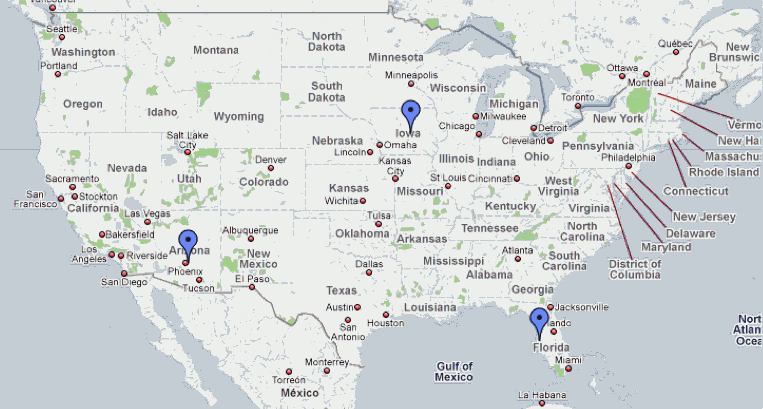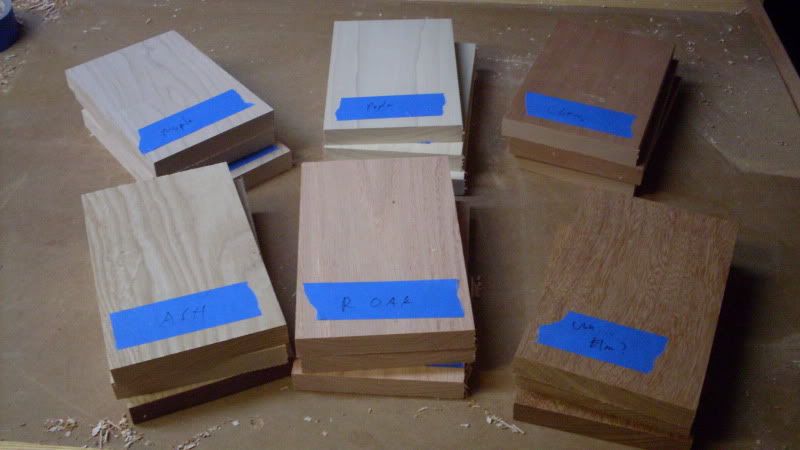Wood moves. As temperature and humidity levels change, wood’s cells will absorb and emit water to reach an equilibrium point. Sure, it can be slowed down by a wood finish, but it can’t be eliminated.
This is a universal truth that all woodworkers need to understand when they build a project. All too often, woodworkers need to learn this lesson at least once the hard way before it truly sinks in.
Sure, there are lots of tables and charts that will tell you exactly how much wood will move, but to get a real life idea, I’ve decided to set up a little experiment. My shop is in the Tampa Bay area, and I’ve enlisted the help of two talented woodworkers who live in different areas of the country with wildly different weather conditions.
First is the Wood Whisperer himself, Marc Spagnuolo. Marc lives in the greater Phoenix, Arizona area. The other woodworker helping me out is Dave Campbell, deputy editor of Wood Magazine. Dave calls the greater Des Moines, Iowa home.
While this is a wood-based article, it also gives me a chance to strut my weather geekiness in the name of woodworking. It’s obvious that changes in latitude will have a dramatic effect on the weather, but geography and location from the nearest large body of water will also play a part in the picture.
To help you understand the differences, I will reference the mean daily temperature and dew points for each city. Why these two readings? First, the mean temperature is an average temperature of the air as indicated by a properly exposed thermometer during a given time period, usually a day, month, or year. This way, we don’t have to wonder about abnormal cool snaps or heat waves – the data will be a little more smoothed out and better representative of a typical day. In this case, we’ll look at the mean temperature of a given day – May 25 – for each of our cities.
The other reading is the dew point, which is the temperature at which the air becomes saturated and produces dew or – if it’s cold enough – frost. Why not use relative humidity? Well, relative humidity is – errr – relative to the temperature, and will rise as the air cools off overnight and drop as the air warms. The dew point produces a better apples-to-apples measurement for our purposes.
Here are some of the stats from the cities:
Tampa, Florida – May 25 mean temperature 79 degrees F, Dew Point 69 degrees.
Lying in the humid subtropical zone, Tampa’s prevailing winds pull hot, moist air off the Gulf of Mexico and the western Caribbean Sea and push it ashore. This leads to exceptionally hot and humid conditions, with frequent thunderstorms throughout the late spring and summer. Basically, you can take a shower and, unless you are in an air conditioned building, never truly dry off.
Des Moines, Iowa – May 25 mean temperature 65 degrees, Dew Point 55 degrees
While Des Moines is at a much higher latitude than Tampa, the prevailing summer winds will still push hot humid air from the Gulf of Mexico. However, at this time of the year, both cooler and warmer air masses are still battling for possession of the region, which leads to variability in the conditions until the summer pattern truly sets in.
Phoenix, Arizona – May 25 mean temperature 84 degrees, Dew Point 30 degrees
Phoenix is in a very hot, arid climate, It’s too far west to be affected by Gulf moisture, and the Rocky Mountain complex to the west cuts off Pacific moisture. I’ve heard it described as standing in front of a giant hair dryer… This is not to say that Phoenix doesn’t get rain. In fact, by late July, a monsoonal flow will come off the Gulf of California, leading to a rise in humidity and thunderstorms. So, we’re hitting Phoenix at an ideal time for this test.
The wood samples for this test have been cut from plain old boards that have been acclimating in my shop for – I dunno – as long as five years. I chose a series of samples from frequently used cabinet woods to give a good representation of what most woodworkers will use. They include; maple, poplar, cherry, ash, red oak and a surprise board.
Yes, it’s a surprise to me, because I picked up what I thought was ash from my hardwood supplier. Got it for a steal – rough – at $1 a board foot. However, once I started planing it for this experiment, well, it’s not ash. I’m going to guess from the photo that it’s red elm, but I could be way off base. Maybe one of my esteemed panelists will be able to put a better ID on it. Hey, at least it’s a different species!
I planed, ripped and crosscut the boards to exactly 5” wide and 8” long. I will be shipping the boards by US Postal Service tomorrow (today is Memorial Day, an official federal holiday) to Marc and Dave with a copy of the steel ruler I used to measure the boards. I took the time to ensure the measurements on each rule lined up to give as accurate a reading as possible.
I have asked both Marc and Dave to let the boards sit in their shops for two weeks, then measure the board samples on June 8 to see what kind of changes have occurred. How will the boards react to the changes in temperature and humidity?
Stay tuned…




This is a great idea. I’m looking forward to the results.